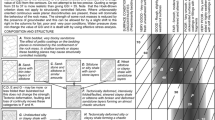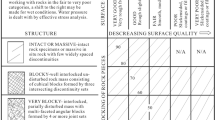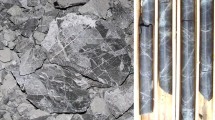Abstract
This article introduces a new quantitative model for the geological strength index (GSI) based on attribute mathematics theory. This new attribute evaluation index system of GSI consists of the rock mass block index, the joint spacing, the number of joint sets, the absolute weathering index, the large-scale undulation, and the small-scale undulation. Recently, based on attribute mathematics theory, the attribute mathematics evaluation model of GSI was established for identifying and classifying the geological strength index. Finally, based on the confidence criterion and the method of linear interpolation, a quantitative model for the geological strength index is established. To verify the model, an improved numerical method is introduced. Meanwhile, the equivalent transformation method of the Hoek–Brown strength criterion and Mohr–Coulomb strength criterion is cited. The problems in the determination of the reinforcement time to support surrounding rock are solved by the analysis of the construction process mechanics. A new concept called section displacement deviation is proposed for effective comparison of the monitoring data and the simulation predictions. Project applications prove that this quantitative method has strong pertinence and high accuracy and can organically combine geological surveys, experimental data, statistics, and expert opinions, so this evaluation method can decrease the subjectivity of research decisions. The method of the attribute mathematics evaluation of GSI provides a new approach to quantifying the GSI system.








Similar content being viewed by others
References
Bar N, Barton N (2017) The Q-slope method for rock slope engineering. Rock Mech Rock Eng 50:3307–3322
Barton N (2002) Some new Q-value correlations to assist insite characterisation and tunnel design. Int J Rock Mech Min Sci 39:185–216
Bieniawski ZT (1989) Engineering rock mass classification. New York: Science Press 1989:180–250
Cai M, Kaiser PK (2006) Visualization of rock mass classification systems. Geotech Geol Eng 24:1089–1102
Cai M, Kaiser PK, Uno H, Tasaka Y, Minami M (2004) Estimation of rock mass deformation modulus and strength of jointed hard rock masses using the GSI system. Int J Rock Mech Min Sci 41:3–49
Cheng Q (1997) Attribute recognition theoretical model with application. Universitatis Pekinnensis, Acta Scientianrum Naturalium 33(1):12–20 (in Chinese)
Feng WK, Dong S, Wang Q, Yi XY, Liu ZG, Bai HL (2018) Improving the Hoek-Brown criterion based on the disturbance factor and geological strength index quantification. Int J Rock Mech Min Sci 108:96–104
Hoek E (1990) Estimating Mohr-Coulomb friction and cohesion values from the Hoek-Brown failure criterion. Int J Rock Mech Min Sci Geomech Abstr 27(3):227–229
Hoek E, Carranza-Torres C, Corkum B (2002) Hoek-Brown failure criterion—2002 edition. Hammah R, Bawden W F, Curran J, et al. ed. Proceedings of the North American Rock Mechanics Society NARMS-TAC 2002. Toronto: University of Toronto Press, 2002:267–273
Hoek E, Carter TG, Diederichs MS (2013) Quantification of the geological strength index chart. In: Proceedings of 47th US Rock Mechanics / Geomechanics Symposium. San Francisco; 23–26 June
Hoek E, Brown ET (1997) Practical estimates of rock mass strength. Int J Rock Mech Min Sci 34:1165–1186
Hoek E, Diederichs MS (2006) Empirical estimation of rack mass modulus. Int J Rock Mech Min Sci 43:203–215
Hu XW, Zhong PL, Ren ZG (2002) Rock mass block index and its engineering practice significance. J Hydraul Eng 33:80–84 (in Chinese)
Li LP, Sun SQ, Wang J et al (2020a) Experimental study of the precursor information of the water inrush in shield tunnels due to the proximity of a water-filled cave. Int J Rock Mech Min Sci 130:104320
Li LP, Sun SQ, Wang J et al (2020b) Development of compound EPB shield model test system for studying the water inrushes in karst regions. Tunn. Undergr. Space Technol 101:103404
Li SC, Shi SS, Li LP (2013) Attribute identification model and its application of mountain tunnel collapse risk assessment. J Basic Sci Eng 21:147–158 (in Chinese)
Lin DM, Sun Y, Zhang W, Yuan RM, He WT, Wang B, Shang YJ (2014) Modifications to the GSI for granite in drilling. B Eng Geol Environ 73:1245–1258
Marinos P, Hoek E. (2000) GSI: A geologically friendly tool for rock-mass strength estimation. in: Proceedings GeoEng2000 International Conference on Geotechnical and Geological Engineering. Melbourne 1422–1446
Marinos V, Carter TG (2018) Maintaining geological reality in application of GSI for design of engineering structures in Rock. Eng Geol 239:282–297
Russo G (2009) A new rational method for calculating the GSI. Tunn Undergr Space Technol 24:103–111
Saaty TL (1990) How to make a decision: the analytic hierarchy process. Eur J Oper Res 48:9–26
Schlotfeldt P, Carter TG (2018) A new and unified approach to improved scalability and volumetric fracture intensity quantification for GSI and rockmass strength and deformability estimation. Int J Rock Mech Min Sci 110:48–67
Sonmez H, Ulusay R (1999) Modifications to the geological strength index (GSI) and their applicability to stability of slopes. Int J Rock Mech Min Sci 36:743–760
Sonmez H, Ulusay R (2002) A discussion on the Hoek-Brown failure criterion and suggested modifications to the criterion verified by slope stability case studies. Yerbilim Bull Earth Sci 26(1):77–99
Sonmez H, Gokceoglu C, Ulusay R (2004) Indirect determination of the modulus of deformation of rock masses based on the GSI system. Int J Rock Mech Min Sci 41:849–857
Su YH, Feng LZ, Li ZY, Zhao MH (2009) Quantification of elements for geological strength index in Hoek-Brown criterion. Chin J Rock Mech Eng 24:103–111 (in Chinese)
Sun JS, Jin L, Jiang QH, Zhou CB, Lu WB (2011) Study on the loosening mechanism of joint surrounding rock induced by transient stress adjustment during underground blasting excavation. J Vib Shock 30:28–34 (in Chinese)
Winn K, Wong LNY (2019) Quantitative GSI determination of Singapore’s sedimentary rock mass by applying four different approaches. Geotech Geol Eng 37:2103–2119
Zhou ZQ, Li SC, Li LP, Shi SS, Song SG, Wang K (2013) Attribute identification model of fatalness assessment of water inrush in karst tunnels and its application. Rock Soil Mech 34:818–826 (in Chinese)
Funding
This work was supported by the National Science Fund for Excellent Young Scholars (No. 51722904), National Natural Science Foundation of China (No. 51679131), China Postdoctoral Science Foundation (2019M652383, 2020T130378), and Postdoctoral Innovation Program of Shandong Province (202002008).
Author information
Authors and Affiliations
Corresponding author
Rights and permissions
About this article
Cite this article
Li, L., Yang, G., Liu, H. et al. A quantitative model for the geological strength index based on attribute mathematics and its application. Bull Eng Geol Environ 80, 6897–6911 (2021). https://doi.org/10.1007/s10064-021-02358-4
Received:
Accepted:
Published:
Issue Date:
DOI: https://doi.org/10.1007/s10064-021-02358-4




